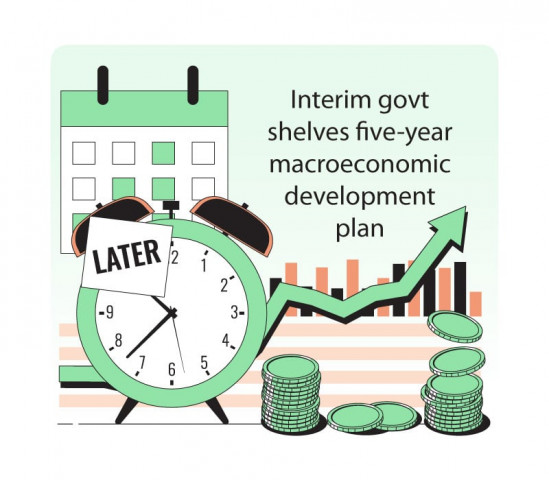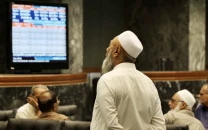Five-year plan unveiling delayed
Lack of preparation, mandate concerns stall key initiatives

The interim government will not present Pakistan’s 13th five-year plan before the National Economic Council due to a lack of preparation and questions over its mandate – the common reasons behind almost every important matter that the caretakers have picked but could not deliver.
Government sources said that instead of tabling a draft of the 2024-29 13th five-year plan before the NEC on Monday, the Ministry of Planning is going to seek approval of the socioeconomic objectives of the five-year plan.
The objectives are general statements that the NEC, Pakistan’s constitutional body responsible for approving macroeconomic and development plans, is going to stamp on January 29th.
The interim government had decided to seek the approval of the NEC for the 13th plan, and the planning commission had been instructed to prepare the plan. The Express Tribune has seen a few drafts of these chapters, which still remain a work in progress.
The sources said that during internal discussions, it was decided that the caretakers should leave the medium to long-term macroeconomic planning to the next government. It is the fourth such high-profile issue where the caretakers seem to be backtracking after beginning work with fanfare.
The finance minister’s attempt to restructure the Federal Board of Revenue has not met with success due to half-baked work. The law minister of the caretakers has told the cabinet that it cannot legislate to give effect to the FBR restructuring. The privatisation minister is struggling with the agenda of selling Pakistan International Airlines. The Election Commission of Pakistan on December 19th barred the interim government from proceeding ahead with the PIA privatisation plan on the grounds that it is not the mandate of the caretaker government.
The energy minister’s work to retire the Rs1.27 trillion circular debt out of Rs5.73 trillion has ended at the table of the finance ministry.
Chief of the Army Staff, General Asim Munir on Wednesday cited Pakistan’s first five-year (1955-60) plan in his speech to the youth and credited it for the agricultural sector revolution in the country.
Interim Prime Minister Anwaarul Haq Kakar will chair the NEC meeting, which would take up six agenda items, including a proposal to shelve the provincial nature projects being funded by the federal government.
However, three provincial governments have already objected to calling the NEC meeting in a matter that does not pertain to the mandate of the interim government to take a decision on the matter.
The sources said that the 13th five-year plan would now be tabled before the NEC meeting likely to be convened at the time of approval of next fiscal year’s budget.
In its technical report released last month, the International Monetary Fund had said that the lack of a comprehensive medium-term planning document weakens the link between the aspirations for the economic development of Pakistan and their achievement through public infrastructure projects.
Read K-P urges special NMD package in 5-year plan
Since 1993, Pakistan has not been implementing the five-year plans, although these documents were prepared after almost every five years. The IMF has now advised Islamabad to shift back to the five-year economic plan model.
In its summary statement of socioeconomic objectives, the planning commission has said that the new plan will take cognisance of reforms introduced under IMF programmes and the underlying strategy of deep and sustained reforms in areas such as public sector management, developing competitive markets, urban management and connecting people and places — as a way forward for accelerating growth to above 5%.
It underlined that the 13th five-year plan is being prepared in the backdrop of socio-economic imbalances and structural bottlenecks. The challenges to the economy are regaining macroeconomic stability; revival of economic growth on the back of improved social indicators; resolving fiscal retrenchment; and the long-term sustainability and solvency of the external sector.
The interim government has proposed the provision of additional domestic resource mobilisation and optimising the use of available resources in the most efficient and effective manner and curbing wasteful expenditures as the key objective for the next five years.
It has also suggested that improving the quality of human capital through moving into the knowledge economy should also be part of the objectives along with attaining universal primary enrolment.
Secondary school’s education, with marked improvement in the quality of education, shifting health strategy from curative to preventive care and assuring the provision of healthcare to all on an equitable basis are other key priority areas.
Among the objectives are preventing hunger, improving nutrition outcomes, promoting gender equality, and ensuring girls’ access to education, health and new employment opportunities and revamping the structure of technical and vocational education to synchronise it with marketable skills.
The caretakers have also proposed reducing poverty through enlarging and better targeting income support and social protection measures and creation of productive and decent employment. The other identified area is balancing regional development through redirecting resources to accelerate growth in less developed and deprived areas.
The socio-economic objectives statement says that agricultural sector growth will be obtained through crop substitution in favour of high yielding crops, efficiency of water management, infusion of technology and innovation and productivity enhancement investment.
Published in The Express Tribune, January 27th, 2024.
Like Business on Facebook, follow @TribuneBiz on Twitter to stay informed and join in the conversation.


















COMMENTS
Comments are moderated and generally will be posted if they are on-topic and not abusive.
For more information, please see our Comments FAQ